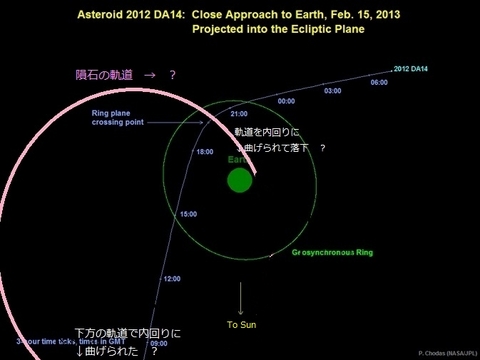
NASA/JPLの軌道図
2013/02/16T06:00:02.59から10秒間露光
2013/02/16T05:59:02.00から10秒間露光
2013/02/16T05:58:13.22から9秒間露光
2013/02/16T05:57:02.50から10秒間露光
2013/02/16T05:56:06.00から10秒間露光
2013/02/16T05:55:07.13から10秒間露光
2013/02/16T05:54:01.85から10秒間露光
2013/02/16T05:53:02.00から10秒間露光
2013/02/16T05:52:02.00から10秒間露光
2013/02/16T05:51:02.00から10秒間露光
2013/02/16T05:50:02.38から10秒間露光
2013/02/16T05:49:02.01から10秒間露光
2013/02/16T05:48:02.07から10秒間露光
2013/02/16T05:47:02.00から10秒間露光
2013/02/16T05:46:02.00から10秒間露光
2013/02/16T05:45:02.00から10秒間露光
2013/02/16T05:44:02.59から10秒間露光
2013/02/16T05:43:02.00から10秒間露光
2013/02/16T05:42:02.31から10秒間露光
2013/02/16T05:41:03.78から9秒間露光
2013/02/16T05:40:02.00から10秒間露光
2013/02/16T05:39:02.00から10秒間露光
2013/02/16T05:38:03.00から9秒間露光
2013/02/16T05:37:02.02から10秒間露光
2013/02/16T05:36:02.00から10秒間露光
2013/02/16T05:35:02.00から11秒間露光
2013/02/16T05:34:02.08から10秒間露光
2013/02/16T05:33:02.15から10秒間露光
2013/02/16T05:32:06.18から9秒間露光
2013/02/16T05:31:02.00から10秒間露光
2013/02/16T05:30:02.01から10秒間露光
2013/02/16T05:29:03.00から10秒間露光
2013/02/16T05:28:02.00から10秒間露光
2013/02/16T05:27:02.00から10秒間露光
2013/02/16T05:26:02.00から10秒間露光
2013/02/16T05:25:03.00から10秒間露光
2013/02/16T05:24:03.00から10秒間露光
2013/02/16T05:23:03.20から10秒間露光
2013/02/16T05:22:02.29から10秒間露光
2013/02/16T05:21:01.89から9秒間露光
2013/02/16T05:20:02.00から10秒間露光
2013/02/16T05:19:03.00から10秒間露光
2013/02/16T05:18:02.00から10秒間露光
2013/02/16T05:17:03.00から10秒間露光
2013/02/16T05:16:01.90から10秒間露光
2013/02/16T05:15:03.00から10秒間露光
2013/02/16T05:14:01.68から10秒間露光
2013/02/16T05:13:02.00から10秒間露光
2013/02/16T05:12:02.78から9秒間露光
2013/02/16T05:11:02.00から10秒間露光
2013/02/16T05:10:02.23から10秒間露光
2013/02/16T05:09:02.00から10秒間露光
2013/02/16T05:08:02.40から10秒間露光
2013/02/16T05:07:02.00から10秒間露光
2013/02/16T05:06:02.00から10秒間露光
2013/02/16T05:05:02.00から10秒間露光
2013/02/16T05:04:02.00から10秒間露光
2013/02/16T05:03:02.00から10秒間露光
2013/02/16T05:02:07.14から9秒間露光
2013/02/16T05:01:02.00から10秒間露光
2013/02/16T05:00:02.00から10秒間露光
2013/02/16T04:59:02.00から9秒間露光
2013/02/16T04:58:02.11から10秒間露光
2013/02/16T04:57:02.00から10秒間露光
2013/02/16T04:56:05.00から9秒間露光
2013/02/16T04:55:02.00から10秒間露光
M95,M96に接近
2013/02/16T04:54:02.01から10秒間露光
2013/02/16T04:53:04.00から9秒間露光
2013/02/16T04:52:02.00から10秒間露光
2013/02/16T04:51:02.00から10秒間露光
2013/02/16T04:50:02.00から10秒間露光
2013/02/16T04:49:02.00から9秒間露光
2013/02/16T04:48:02.00から10秒間露光
2013/02/16T04:47:02.00から10秒間露光
2013/02/16T04:46:02.00から10秒間露光
2013/02/16T04:45:06.12から10秒間露光
2013/02/16T04:44:02.00から10秒間露光
2013/02/16T04:43:02.00から10秒間露光
2013/02/16T04:42:02.00から10秒間露光
2013/02/16T04:41:02.00から10秒間露光
2013/02/16T04:40:02.00から10秒間露光
2013/02/16T04:39:08.00から9秒間露光
2013/02/16T04:38:01.98から9秒間露光
2013/02/16T04:37:02.00から10秒間露光
2013/02/16T04:36:06.36から9秒間露光
2013/02/16T04:35:02.00から9秒間露光
2013/02/16T04:34:02.00から10秒間露光
2013/02/16T04:33:02.00から10秒間露光
2013/02/16T04:32:02.00から10秒間露光
2013/02/16T04:31:02.00から10秒間露光
2013/02/16T04:30:02.00から10秒間露光
2013/02/16T04:29:08.00から10秒間露光
2013/02/16T04:28:02.00から10秒間露光
2013/02/16T04:27:02.00から10秒間露光
2013/02/16T04:26:02.00から10秒間露光
最接近04:25:49
2013/02/16T04:25:02.00から10秒間露光
2013/02/16T04:24:05.14から9秒間露光
2013/02/16T04:23:02.00から10秒間露光
2013/02/16T04:22:02.00から10秒間露光
2013/02/16T04:21:02.00から10秒間露光
2013/02/16T04:52:05.36から9秒間露光
2013/02/16T04:18:48.24から9秒間露光
2013/02/16T04:17:08.03から10秒間露光
2013/02/16T04:16:18.00から10秒間露光
2013/02/16T04:15:22.07から18秒間露光
2013/02/16T04:14:02.00から31秒間露光
ε160/530mm + LPS-P2 + 60D/ISO800 / EM-200Temma2
StellaImage4でレベル補正とリサイズ